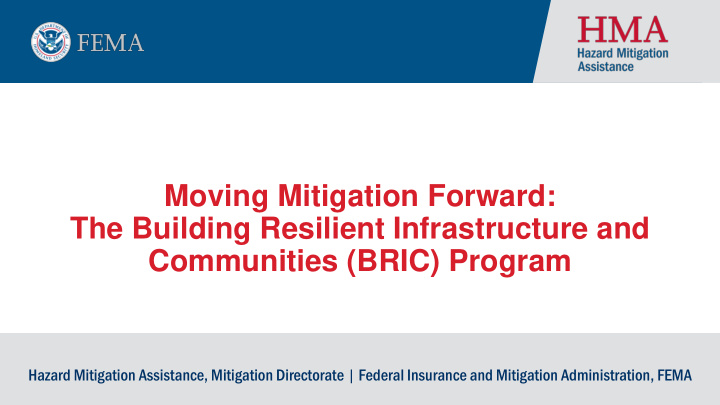



Moving Mitigation Forward: The Building Resilient Infrastructure and Communities (BRIC) Program Hazard Mitigation Assistance, Mitigation Directorate | Federal Insurance and Mitigation Administration, FEMA
Disaster Recovery Reform Act (DRRA) • The most significant opportunity in decades to focus on investing year-in and year-out on mitigation measures that will reduce losses from future disaster events • Establishes nearly 50 new authorities and requirements across FEMA • Designed to address the rising costs of disasters and reform Federal disaster programs 2
DRRA Section 1234: Building Resilient Infrastructure and Communities (BRIC) FEMA’s goal is to reduce costs and loss of human life from natural hazards by building a national culture of preparedness, encouraging investments to protect our communities and infrastructure, and building mitigation capabilities to foster resilience. Since 2009, FEMA has received approximately $1 billion in Pre-Disaster Mitigation grant BRIC Guiding Principles appropriations, of which 48% has been in the last 2 years. Support communities through $250 capability & capacity building $200 Encourage and enable $150 innovation $100 Promote partnerships $50 Enable large projects $0 2009 2010 2011 2012 2013 2014 2015 2016 2017 2018 2019 Maintain flexibility Average amount from 2009-2016: Avg. from 2017-2019: $56M/year. $200M/year. Provide consistency Funds will vary based on disasters. FIMA estimates that annual funds will average $300M- $500M per year, with significantly greater amounts following years with catastrophic 3 disasters.
Pre-Disaster Mitigation (PDM) and BRIC: Path Forward Total amount available: Will ensure continuous PDM FY18 Total amount PDM FY19 Total amount BRIC FY20 BRIC FY21 & beyond TBD improvement as the available: available: program evolves $249,200,000 $250,000,000 Target application period is September FEMA will communicate Resilient Follows same 2020 – January 2021 annual changes through Infrastructure: application timeline as the Notice of Funding New competitive FY18 Opportunity and funding project type Resilient program with a maximum Infrastructure implementation Federal share of competitive funding documents $10,000,000 will continue $250M $353M Planned for Accrued FY19 PDM 4
BRIC Program Design Process and Estimated Timing BRIC Milestones Public Comment through Notice of Grant Application Research Policy and Federal Register and Funding Period Opens Program 2018 - Fall 2019* Adjudicate Comments Opportunity Development and Fall 2020* Reviews Spring 2020* Summer 2020* Summer 2019 – 2020* * Timing is estimated as of September 2019 and subject to change. 5
Infrastructure and Lifeline Considerations ✓ Project types ✓ Period of Performance ✓ Advance Assistance opportunities ✓ Private sector ownership ✓ New technical considerations ✓ Role of planning ✓ Technical assistance needs ✓ Funding amounts and caps ✓ Nature-based infrastructure 6
Resilient Infrastructure: Example 6-acre underground resiliency park in NJ offers 8 Drainage areas outdoor public recreation amenities such as a natural oasis, athletic fields, play areas, fitness stations, and event space: 7 Landscape types – Lowered basketball court provides green stormwater storage 1.75 M – Rain gardens for capture and filtration ✓ Provides significant mitigation of fluvial and Gallons of stormwater flash flooding for multi-story residential, storage commercial, and industrial properties $ 10 M FED SHARE ✓ Reduces economic, environmental, and + $ 47 M social impacts MATCH 7
Stakeholder Engagement Since the passage of the DRRA FEMA has conducted extensive stakeholder engagement through: ❖ In-Person Meetings ❖ Webinars ❖ Open Inbox ❖ Ideascale Platform buildbric@fema.dhs.gov ❖ Formal Letters 8
Formal Comment Letters FEMA does not endorse any non-government entities, organizations, or services. 9
Commonly Supported Ideas Generally, stakeholders expressed support for: Increased funding for technical assistance and Large and small mitigation activities capability and capacity-building activities Simplifying the process for shifts to budgets, Evaluation and performance monitoring of processes, and work schedules that result in BRIC-funded projects no changes to scope of work – especially necessary for large projects Adoption and enforcement of recent building codes while allowing for flexibility Expansion of pre-calculated benefits Lesson sharing of successful projects at Consistency across pre-existing mitigation various scales programs Collaboration with other agencies and organizations to develop and support BRIC-related activities 10
BRIC Supports FEMA’s Priorities Build a culture of Prepare the nation for Reduce complexities preparedness catastrophic disasters BUILDBRIC@fema.dhs.gov 11
Recommend
More recommend